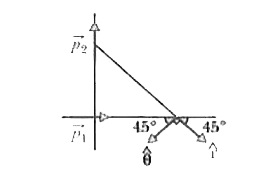A dipole of dipole moment p is placed at origin along x axis. Another dipole of dipole moment also p is kept at (0, 1, 0) along y axis. Find the resultant potential and electric field at (1, 0, 0).
We have studied that the electric field and potential both obey the law of superposition. We can find the electric field and the potential due to each of the dipole at the point concerned and then add them. The caution to be exercised is that while finding the electric field/potential due to a given dipole, we need to consider the center of that dipole as the origin.
Calculation: Due to the first dipole at the origin, the potential is
V1=kpcosθr2=kp12=kp
Due to the second dipole at y = 1, the potential is
V2=kpcosθr2=kp√22cos135∘=kp2√2
Therefore,
V=V1+V2=kp−kp√24 . (Answer)
Similarly, the electric field in the radial direction due to the first dipole is
Er1=2kpcos0r3ˆi=2kpˆi.
Here, the radial direction is also the x direction as can be seen from Fig. 24-35.
Ep1=2kpsin0r3ˆj=0ˆj.

Here, the polar direction is the positive y direction.
The magnitude of the electric field in the radial direction due to the second dipole is
−cos45ˆi−sin45ˆjEr2=2kp2√2cos135∘=−kp2.
Here, the radial direction is shown in Fig. 24-36. A unit vector in the radial direction will be cos 45ˆi−sin45ˆj. So,
Er2=−kp2(ˆi√2−ˆj√2).
Similarly, the electric field in the polar direction will be given by
−−→Ep2=kpsin135∘(√2)3(−ˆi√2−ˆj√2).

Because a unit vector in polar direction will be −cos45ˆi−sin45ˆj, so we have
→E=2kpˆi−kp2√2ˆi+kp2√2ˆj−kp4√2ˆj−kp4√2ˆi−kp4√2ˆj
=⎛⎜
⎜⎝kp(8√2−3)ˆi4√2+kpˆj4√2⎞⎟
⎟⎠. (Answer)
Topper's Solved these Questions
- ELECTRIC POTENTIALBook:RESNICK AND HALLIDAYChapter:ELECTRIC POTENTIALExercise:SAMPLE PROBLEM 24.20 Dipole moment of combination of three charges
Explore 1 Video
- ELECTRIC POTENTIALBook:RESNICK AND HALLIDAYChapter:ELECTRIC POTENTIALExercise:SAMPLE PROBLEM 24.21 Potential energy of a system of three charged particles
Explore 1 Video
- ELECTRIC POTENTIALBook:RESNICK AND HALLIDAYChapter:ELECTRIC POTENTIALExercise:SAMPLE PROBLEM 24.18 Electric field due to a dipole at a point on dipole axis
Explore 1 Video
- ELECTRIC CHARGES AND FIELDSBook:RESNICK AND HALLIDAYChapter:ELECTRIC CHARGES AND FIELDSExercise:Practice Questions (Integer Type )
Explore 3 Videos
- ELECTROMAGNETIC INDUCTIONBook:RESNICK AND HALLIDAYChapter:ELECTROMAGNETIC INDUCTIONExercise:PRACTICE QUESTIONS (Integer Type)
Explore 14 Videos
Similar Questions
Two short dipoles, each of diple moment p , are placed at origin. The dipole moment of one dipole is along x-axis, while that of other is along y-axis . The electric field at a point (a,0) is given by
View SolutionAn electric dipole of dipole moment p is placed in a uniform external electric field E. Then, the
View Solution
Knowledge Check
Two short dipoles, each of diple moment p , are placed at origin. The dipole moment of one dipole is along x-axis, while that of other is along y-axis . The electric field at a point (a,0) is given by
A(14πε0)2pa3B(14πε0)pa3C(14πε0)√5pa3DZeroAn electric dipole of dipole moment p is placed in a uniform external electric field E. Then, the
Atoeque experienced by the dipole is E×pBtorque is zero, if p is perpendicular to ECtorque is maximum, if p is perpendicular to EDpotential energy is maximum, if p is parallel to EA dipole of dipole moment P is kept at the centre of a ring of radius R and charge Q the dipole moment has direction along the ring due to the dipole is :
AzeroBkpQR3C2kpQR3DkpQR3 only if the change is uniformly distributed on the ring .
An electric dipole is placed along x-axis with its centre at origin:
View SolutionA dipole is placed at the origin such that its dipole moment is →p=−pˆi, The electric field and potential at (0,d,0) respectively are :
View SolutionAn electric dipole is placed along x-axis with its centre at origin:
View SolutionA dipole of dipole moment 'p' is placed in a non-uniform electric field along x-axis. Electric field is increasing at the rate of 1V/m2 then the force on dipole is :-
View SolutionA dipole is placed at the origin such that its dipole moment is →p=−pˆi,0. The electric field and potential at (0,d,0) respectively are :
View Solution

